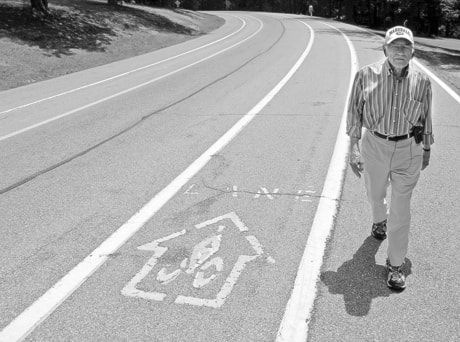On any given day around noon, you won’t likely find Dick Fisher sitting indoors.
The 82-year-old prides himself on spending time outdoors at least once a day, usually for a brisk three-km walk in Pittsburgh’s North Park. He walks the same path whether it’s July or January, and he’s done it for 15 years.
“It’s become a habit,” he said. “I just don’t feel right if I don’t do it.”
Fisher recognizes the benefits of outdoor activity at any stage in life, and attributes his strong physical condition to the daily 40-minute trek.
“It’s my routine,” he said, adding that the exercise has helped him rebound from several surgeries. “I’m not out to break any distance or speed records, but it’s done my body a lot of good.”
Fisher’s steady outdoor walking regimen is one that all seniors should try to emulate, according to Dr. Robert Palmer, clinical director of geriatric medicine at the University of Pittsburgh Medical Center. The simple habit of taking low-impact, daily walks can substantially increase seniors’ mental and physical health, he said.
“When the weather is pleasant, going outdoors for even a brief walk is very therapeutic for cardiovascular effects and improving endurance,” he said. “It keeps circulation normal and helps cognition by preventing memory loss.”
Safe exposure to sunlight on an outdoor trail can increase levels of Vitamin D, an additional health benefit.
For some, Palmer said it might be feasible to incorporate more physically demanding activities like biking and swimming into an exercise plan: “They’re very good aerobic activities that can benefit the heart.”
Seniors who want to increase physical endurance but feel unable to attempt such exertion can certainly reach their goal while walking, he said. They can improve strength and stamina by selecting more challenging courses with slopes and hills.
“Walking up and down hills strengthens leg and hip muscles and helps with better balance,” he said. “It’s something simple and doable — almost anyone can go for a walk.”
Older, more arthritic seniors might be hesitant to hit the pavement if they suspect it might do their joints “more harm than good.” The actual effects, however, are quite the opposite.
“Studies show that walking with arthritic knees reduces pain and need for medication,” Palmer said. “It also improves quality of life and mood.”
Dan Bickel, park manager at Moraine State Park in Pittsburgh, recommends that seniors improve their technology skills along with exercise. In geocaching, which is quickly gaining popularity in outdoor circles, treasure-hunters follow a handheld global positioning system unit to find a prize stashed in a secret location.
“Seniors get pretty proficient at using the GPS at the end of the program,” Bickel said. “It’s good for seniors whose kids buy them a GPS and they want to learn how to use it.”
Jennifer Rizzi can be reached at jrizzi@post-gazette.com. For more stories, visit scrippsnews.com
